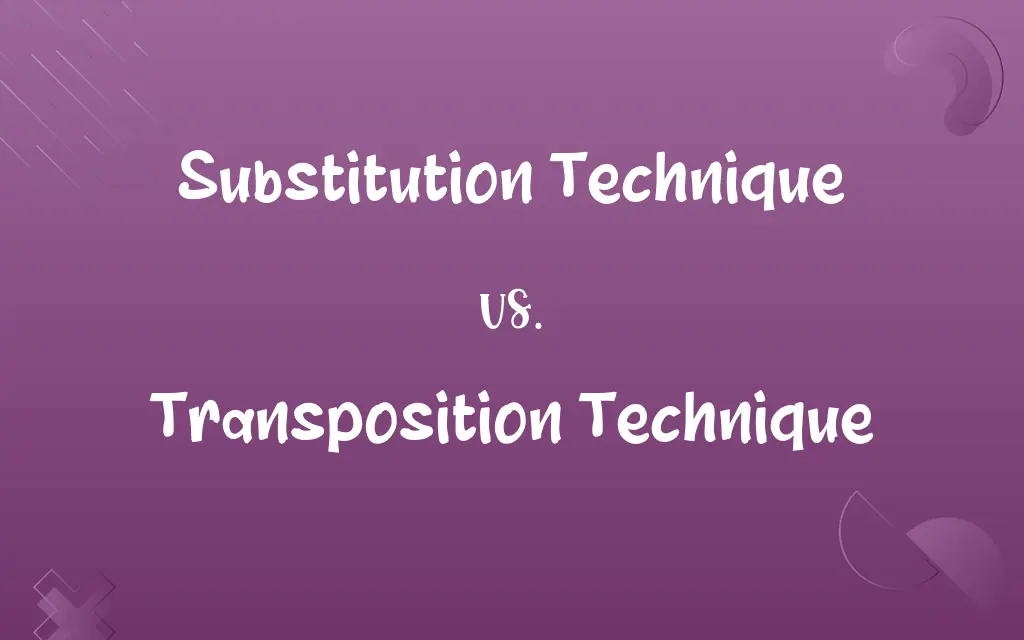Substitution Technique vs. Transposition Technique: Know the Difference

By Shumaila Saeed & Hifza Nasir || Published on November 9, 2024
Substitution technique replaces characters in plaintext with other characters, symbols, or numbers. Transposition technique rearranges the positions of characters in plaintext.

Key Differences
The substitution technique in cryptography involves the replacement of characters in the plaintext with other characters, symbols, or numbers according to a certain system or key. This method alters the appearance of the message without changing the order of the characters. On the other hand, the transposition technique encrypts information by rearranging the positions of the characters in the plaintext. Unlike substitution, transposition does not alter the actual characters but changes their sequence, making the plaintext unreadable.
Shumaila Saeed
Nov 09, 2024
One of the oldest examples of the substitution technique is the Caesar cipher, where each letter in the plaintext is shifted a certain number of places down or up the alphabet. In contrast, a classic example of the transposition technique is the rail fence cipher, where characters are written down in zigzag on multiple levels (rails), and the message is then read off level by level.
Hifza Nasir
Nov 09, 2024
Substitution ciphers can be more straightforward to implement and understand but might be easier to break if the substitution method is simple or well-known. Frequency analysis, for instance, can be an effective method to crack some substitution ciphers, as certain letters or combinations appear more frequently in a language. Transposition ciphers, while also vulnerable to cryptanalysis, offer a different layer of security by keeping the plaintext characters intact but hidden through rearrangement.
Shumaila Saeed
Nov 09, 2024
Combining both techniques can significantly enhance the security of the encrypted message. For example, a message could first undergo substitution to replace its characters, followed by a transposition to scramble the positions of the substituted characters. This combination creates a more complex cipher that is much harder to decrypt without knowledge of the specific methods and keys used.
Hifza Nasir
Nov 09, 2024
Both techniques are foundational in the field of cryptography, their effectiveness alone against modern computational analysis is limited. Today, these methods are often used in educational contexts or as components within more complex encryption algorithms, highlighting the evolution of cryptographic techniques in response to increasing security needs.
Dua Fatima
Nov 09, 2024
ADVERTISEMENT
Comparison Chart
Basic Operation
Replaces characters with others.
Rearranges the positions of characters.
Shumaila Saeed
Nov 09, 2024
Vulnerability
Susceptible to frequency analysis.
Can be analyzed through patterns of character rearrangement.
Shumaila Saeed
Nov 09, 2024
Implementation Ease
Generally simpler to implement.
Might require more complex algorithms for rearranging.
Dua Fatima
Nov 09, 2024
Security
Can be high if the substitution method is complex.
Enhanced by complexity of the transposition pattern.
Hifza Nasir
Nov 09, 2024
ADVERTISEMENT
Substitution Technique and Transposition Technique Definitions
Substitution Technique
Offers straightforward encryption methods.
Rot13 where each letter is replaced by the letter 13 positions ahead.
Hifza Nasir
Feb 26, 2024
Transposition Technique
Effective in combination with other techniques.
First applying a substitution cipher, then a transposition cipher.
Hifza Nasir
Feb 26, 2024
Substitution Technique
Susceptible to frequency analysis attacks.
'E' is the most common letter in English.
Hifza Nasir
Feb 26, 2024
Transposition Technique
Harder to decrypt without knowledge of the pattern.
Knowing the number of rows in a rail fence cipher is key.
Shumaila Saeed
Feb 26, 2024
Substitution Technique
Can utilize symbols or numbers as replacements.
'E' might be represented by '3'.
Hifza Nasir
Feb 26, 2024
ADVERTISEMENT
Transposition Technique
Can be complex depending on the transposition method.
A scrambled route cipher uses a complex path pattern.
Hifza Nasir
Feb 26, 2024
Substitution Technique
Useful for creating simple, quick ciphers.
Replacing every letter with its opposite (A <-> Z).
Shumaila Saeed
Feb 26, 2024
Transposition Technique
Encrypts by changing character positions.
HELLO might be rearranged to LEHOL.
Hifza Nasir
Feb 26, 2024
Substitution Technique
Involves replacing each character with another.
'A' becomes 'D' in a simple shift cipher.
Shumaila Saeed
Feb 26, 2024
Transposition Technique
Maintains the original text characters but alters order.
A columnar transposition rearranges characters in columns.
Shumaila Saeed
Feb 26, 2024
Repeatedly Asked Queries
What is the substitution technique in cryptography?
It's a method where characters in the plaintext are replaced with other characters, symbols, or numbers according to a specific system or key.
Hifza Nasir
Nov 09, 2024
Are these techniques secure against modern encryption attacks?
Alone, they may not withstand modern cryptanalysis but can be effective as part of more complex encryption algorithms.
Shumaila Saeed
Nov 09, 2024
Can substitution and transposition techniques be combined?
Yes, combining them can enhance the security of the encryption by adding complexity to the cipher.
Shumaila Saeed
Nov 09, 2024
How do modern encryption algorithms incorporate substitution and transposition?
Modern encryption algorithms, like AES, incorporate complex versions of substitution and transposition in multiple rounds to enhance security through a process known as confusion and diffusion.
Shumaila Saeed
Nov 09, 2024
What are the main differences between substitution and transposition techniques?
The main difference lies in the method of encryption: substitution replaces characters with others, while transposition rearranges the characters' positions without altering the characters themselves.
Hifza Nasir
Nov 09, 2024
What is frequency analysis and how does it affect the security of substitution ciphers?
Frequency analysis is a cryptanalysis technique that examines the frequency of characters or groups of characters in a piece of ciphertext. It exploits patterns inherent in a language to break substitution ciphers by identifying the most commonly used characters or pairs.
Shumaila Saeed
Nov 09, 2024
How does the transposition technique work?
It encrypts information by rearranging the characters' positions in the plaintext without altering the characters themselves.
Hifza Nasir
Nov 09, 2024
Which technique is easier to implement?
Substitution techniques are generally simpler to implement than transposition techniques, which may require more complex algorithms.
Shumaila Saeed
Nov 09, 2024
Are substitution techniques easier to break than transposition techniques?
Substitution techniques, especially simpler ones, can be easier to break using methods like frequency analysis. Transposition techniques might offer better security due to the complexity of deciphering the rearrangement pattern without knowledge of the method.
Hifza Nasir
Nov 09, 2024
Can transposition techniques be applied to digital data other than text?
Yes, transposition techniques can be applied to any digital data where the data units can be rearranged, including binary data, making it versatile in cryptography applications.
Dua Fatima
Nov 09, 2024
What role do substitution and transposition techniques play in educational contexts?
They are often used in educational contexts to teach the fundamentals of cryptography, illustrating basic concepts of encryption and decryption, and the history of cryptanalysis.
Hifza Nasir
Nov 09, 2024
How can one break a transposition cipher without knowing the key?
Breaking a transposition cipher without the key involves looking for patterns in the ciphertext that may hint at the method of transposition, and trying various permutations until the plaintext is revealed, which can be a complex and time-consuming process.
Shumaila Saeed
Nov 09, 2024
Is there any way to make a substitution cipher more secure against attacks?
Increasing the complexity of the substitution, such as using a polyalphabetic cipher that changes the substitution alphabet throughout the message, can make it more secure against frequency analysis and other attacks.
Hifza Nasir
Nov 09, 2024
How do the principles of substitution and transposition techniques apply to the concept of steganography?
While steganography involves hiding the existence of a message rather than encrypting its content, the principles of altering and rearranging information can be analogous to substitution and transposition in the sense of concealing information within other data.
Dua Fatima
Nov 09, 2024
Why are pure substitution or transposition techniques not used in high-security applications today?
Alone, these techniques do not provide sufficient security against the capabilities of modern computational power and advanced cryptanalysis methods. High-security applications require more complex algorithms that combine multiple methods and layers of encryption.
Hifza Nasir
Nov 09, 2024
Share this page
Link for your blog / website
HTML
Link to share via messenger
About Author
Written by
Shumaila SaeedShumaila Saeed, an expert content creator with 6 years of experience, specializes in distilling complex topics into easily digestible comparisons, shining a light on the nuances that both inform and educate readers with clarity and accuracy.
Co-written by
Hifza Nasir







































































